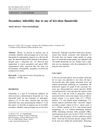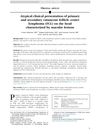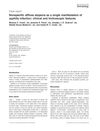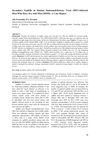Search
for
Sort by
Research
420-450 / 1000+ results
research Possible Association of Female-Pattern Hair Loss with Alteration in Serum 25-Hydroxyvitamin D Levels
Women losing hair might have lower levels of vitamin D.

research Utility of Trichoscopy
Trichoscopy helps diagnose and monitor hair and scalp problems without needing many biopsies.

research Skin Manifestations Associated With Systemic Diseases – Part I
The conclusion is that early diagnosis of skin signs linked to diseases like Lupus, Dermatomyositis, and Rheumatoid Arthritis is crucial to prevent serious complications.
research Optimization and Transfollicular Delivery of Finasteride-Loaded Proniosomes for Hair Growth Stimulation in C57BL/6Mlac Mice
Finasteride-loaded proniosomes effectively promote hair growth in mice.

research A Series of Clinical Cases of Psychocutaneous Disorders in a Dermatology Unit in Albania
The conclusion is that a team of skin doctors and psychiatrists is needed to better treat patients with mind-skin disorders.

research The New Paradigm for Androgenetic Alopecia and Plant-Based Folk Remedies: 5α-Reductase Inhibition, Reversal of Secondary Microinflammation, and Improving Insulin Resistance
Plant-based remedies may treat hair loss by reducing inflammation and improving insulin resistance.

research Scalp Atrophy Secondary to Steroid Use in Patients With Scarring Alopecia: Are Topical Steroids Superior to Topical Calcineurin Inhibitors?
Topical calcineurin inhibitors might be safer than steroids for scarring alopecia, but more research is needed.
research Hapten-Induced Lymphadenosis Benigna Cutis Secondary to Squaric Acid Dibutylester Sensitization for Alopecia Areata
Squaric acid dibutylester for alopecia areata can cause benign skin lymphoid growths.

research Androgenic Alopecia Is Associated With More Severe Lower Urinary Tract Symptoms Secondary to Benign Prostatic Hyperplasia
People with hair loss may have worse urinary symptoms due to an enlarged prostate.

research Trachyonychia Associated with Alopecia Areata and Secondary Onychomycosis
An 8-year-old girl had nail and hair issues that improved without specific treatment, but fungal nail infection was hard to cure.
research Androgenetic Alopecia Among Hospital Staff: A Study of Prevalence, Types, and a Comparison with the General Population in a Secondary Hospital in China
Hospital staff have a higher rate of hair loss than the general population.

research Secondary Infertility Due to Use of Low-Dose Finasteride
Low-dose finasteride may cause fertility issues, but stopping it can improve sperm quality and lead to pregnancy.

research Dermatoscopic Findings of Syphilitic Alopecia
Dermoscopy helps diagnose syphilitic alopecia, and treatment with penicillin can regrow hair.
research Alopecia Mucinosa: Report of a Case and Review
Alopecia mucinosa can be treated successfully with minocycline.

research Androgenetic Alopecia: Modeling Progression and Regrowth
AGA causes hair loss through follicle miniaturization and hair cycle changes; regrowth depends on anagen initiation in kenogen follicles.

research Diffuse Hair Loss in Secondary Syphilis in HIV Positive Man: Case Report
A man with HIV had hair loss due to syphilis, which improved after penicillin treatment.

research Moth-Eaten Symptomatic Syphilitic Alopecia Associated with Human Immunodeficiency Virus: A Case Report
Hair loss in HIV patients should be tested for syphilis as well.

research Syphilitic Alopecia: Report of a Challenging Case and Review of the Literature
A man with syphilitic alopecia and neurosyphilis was successfully treated with penicillin, leading to symptom improvement and resolution of hair loss.

research Bioactive Metabolites of Edible Mushrooms Efficacious Against Androgenic Alopecia: Targeting SRD5A2 Using Computational Approach
Certain compounds found in edible mushrooms may help treat hair loss.

research Androgenetic Alopecia: Mechanisms and Progression
Androgenetic alopecia causes hair loss by shrinking hair follicles due to androgens, with the connection between the muscle and hair follicle determining if the loss is reversible.
research 1,25-Dihydroxyvitamin D Resistance, Rickets, and Alopecia
A genetic defect in vitamin D receptors causes severe rickets and hair loss in children, but some heal as they age.
research Secondary Syphilis in Cali, Colombia: New Concepts in Disease Pathogenesis
Secondary syphilis in Cali, Colombia, shows high Treponema pallidum presence and challenges in early diagnosis, needing better public health strategies.

research Vitamin D Resistant Rickets With Alopecia: A Form of End Organ Resistance to 1,25 Dihydroxy Vitamin D
A girl with rickets and hair loss was found to have a rare condition where her body didn't respond to vitamin D treatment.
research Treatment Success in Three Andean Bears (Tremarctos Ornatus) with Alopecia Syndrome Using Oclacitinib Maleate (Apoquel)
Oclacitinib maleate successfully treated alopecia in Andean bears.

research Atypical Clinical Presentation of Primary and Secondary Cutaneous Follicle Center Lymphoma on the Head Characterized by Macular Lesions
Some skin lymphomas can look like common skin issues and need careful testing to diagnose correctly.

research Nonspecific Diffuse Alopecia as a Single Manifestation of Syphilis Infection: Clinical and Trichoscopic Features
Syphilis can cause hair loss without other symptoms and should be considered when diagnosing unexplained hair loss.

research Selective Janus Kinase 1 Inhibition Resolves Inflammation and Restores Hair Growth Offering a Viable Treatment Option for Alopecia Areata
Blocking Janus kinase 1 helps stop inflammation and regrow hair, making it a good treatment for hair loss from alopecia areata.

research Secondary Syphilis in HIV-Infected Men Who Have Sex with Men: A Case Report
HIV-infected men who have sex with men are at higher risk for aggressive syphilis, but treatment and tests are effective.

research Alopecia Universalis After Alemtuzumab Treatment for Multiple Sclerosis: A Two-Year Follow-Up of Two Patients
Two patients developed complete hair loss after Alemtuzumab treatment for MS, with no regrowth after two years.